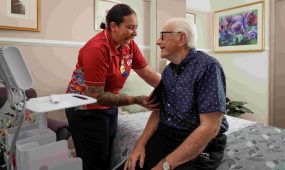Fellowship, fonts and tough decisions on the fly
Reflections
“By and large the business of the Synod is conducted with kindness and good humour and there is a real sense of wanting to find agreement on even the most difficult of matters. This year one of those difficult matters involved the font size used when displaying motions and amendments and the colour used when highlighting text changes. Furious debate ensued and the President of the Synod had to make some tough decisions on the fly,” says Bishop Jeremy Greaves

The third session of the 80th Synod of the Diocese of Brisbane recently concluded its business. Synods have been part of how the Church makes decisions in different places since around the seventh century, and the first diocesan Synod in the (now) Anglican Church of Australia was held in 1855 in the Diocese of Adelaide.
This first Synod happened after a conference of Australian bishops agreed that it might be useful to have Synods to decide matters of discipline, doctrine and worship.
Advertisement
The Diocese of Brisbane was formed in June 1859, with the first Bishop, Edward Tufnell arriving the following year. In 1867 a petition was presented to the Bishop asking that he convene a Diocesan Synod. That first Synod, gathering together clergy and laity, took place in 1868.
Bishop Bruce Kaye comments that, “What all these nineteenth-century Anglicans took for granted, though, was that laity meant laymen. It was not until the twentieth century that lay women could take their place in synods. After the 1920 Lambeth Conference called for female participation at all levels of Anglican government, the Church of England was the first to do this in 1920 at the newly-created General Assembly. In Australia, female synod representation varied from diocese to diocese. They were admitted to the Adelaide synod in 1946, but not in the Diocese of Sydney until 1972.”
Those first Synods were part of the Australian Church forging an independent path from the Church of England in a context very different to that of the “mother Church”. Despite this, Synodical processes have largely been drawn from English parliamentary models reflecting the long tradition of the establishment of the Church of England. Bishop Bruce Kaye wonders if this model is still fit for purpose (if it ever was) as it often sets the stage for binary arguments and winners and losers on the Synod floor. He writes, “… an arrangement which institutionalises an arena of argument is probably never fully able to escape the possibility of it becoming something to be ashamed of.”
Advertisement
I also sometimes wonder whether the Westminster-style of diocesan Synod excludes folk from cultures who are more familiar with round-table dialogue or who find the English parliamentary model adversarial. There are ways this can be addressed and I think consultation with our cultural and linguistically diverse community members is worth pursuing.
However, as this recently published joint Synod reflection shows, Synod is most often a great occasion for community and collegiality, bringing the Diocese together in a way that rarely happens for the rest of the year. Each time the Synod gathers, old friendships are rekindled, stories and meals are shared, we worship together, enjoy each other’s company…and make important decisions about Christ’s Church in this place.
By and large the business of the Synod is conducted with kindness and good humour and there is a real sense of wanting to find agreement on even the most difficult of matters. This year one of those difficult matters involved the font size used when displaying motions and amendments and the colour used when highlighting text changes. Furious and funny debate ensued and the President of the Synod had to make some tough decisions on the fly.
I look forward to contributing my thoughts about Synod fonts — typefaces, not the baptismal kind — in a future anglican focus reflection.






